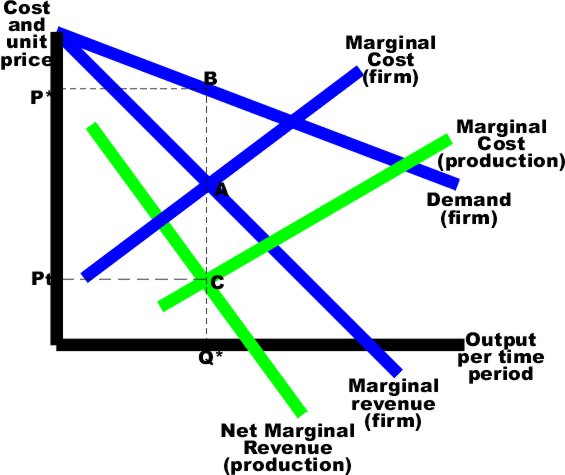Transfer pricing
|
|
Transfer pricing refers to the pricing of goods and services within a multi-divisional organization. Goods from the production division may be sold to the marketing division, or goods from a parent company may be sold to a foreign subsidiary. The choice of the transfer prices affects the division of the total profit among the parts of the company. It can be advantageous to choose them such that, in terms of bookkeeping, most of the profit is made in a country with low taxes.
From marginal price determination theory, we know that generally the optimum level of output is that where marginal costs equals marginal revenue. That is to say, a firm should expand its output as long as the marginal revenue from additional sales is greater than their marginal costs. In the diagram that follows, this intersection is represented by point A, which will yield a price of P*, given the demand at point B.
When a firm is selling some of its product to itself, and only to itself (ie.: there is no external market for that particular transfer good), then the picture gets more complicated, but the outcome remains the same. The demand curve remains the same. The optimum price and quantity remain the same. But marginal cost of production can be separated from the firms total marginal costs. Likewise, the marginal revenue associated with the production division can be separated from the marginal revenue for the total firm. This is referred to as the Net Marginal Revenue in production (NMR), and is calculated as the marginal revenue from the firm minus the marginal costs of distribution.
It can be shown algebraically that the intersection of the firms marginal cost curve and marginal revenue curve (point A) must occur at the same quantity as the intersection of the production divisions marginal cost curve with the net marginal revenue from production (point C).
If the production division is able to sell the transfer good in a competitive market (as well as internally), then again both must operate where their marginal costs equal their marginal revenue, for profit maximization. Because the external market is competitive, the firm is a price taker and must accept the transfer price determined by market forces (their marginal revenue from transfer and demand for transfer products becomes the transfer price). If the market price is relatively high (as in Ptr1 in the next diagram), then the firm will experience an internal surplus (excess internal supply) equal to the amount Qt1 minus Qf1. The actual marginal cost curve is defined by points A,C,D.
Price_trans-comp_ext-small.jpg
alt text
Transfer Pricing with a Competitive External Market
If the market price is relatively low (as in Ptr2), then the firm will experience an internal shortages (insufficient internal supply) equal to the amount Qf2 minus Qt2. The actual marginal cost curve is defined by points A,B,E.
If the firm is able to sell its transfer goods in an imperfect market, then it need not be a price taker. There are two markets each with its own price (Pf and Pt in the next diagram). The aggregate market is constructed from the first two. That is, point C is a horizontal summation of points A and B (and likewise for all other points on the Net Marginal Revenue curve (NMRa)). The total optimum quantity (Q) is the sum of Qf plus Qt.
Price_trans-imperf_ext-small.jpg
alt text
Transfer Pricing with an Imperfect External Market
See also
To read a forum for transfer pricing practitioners see bnatax.com under Transfer Pricing.

